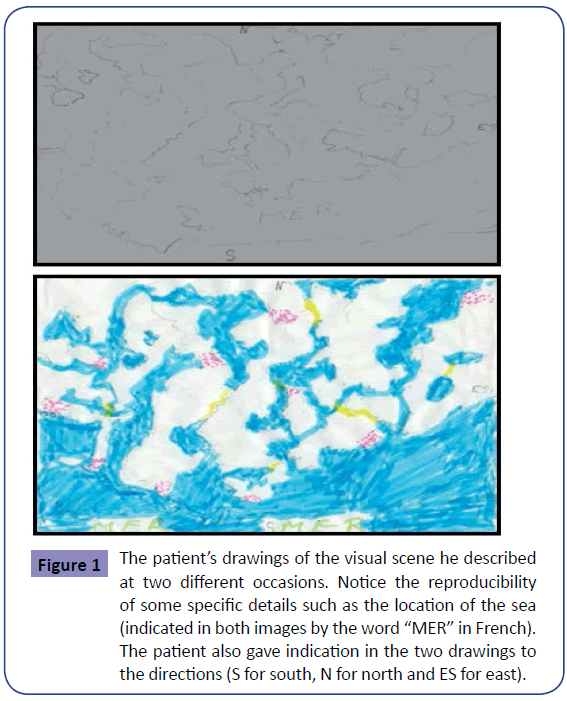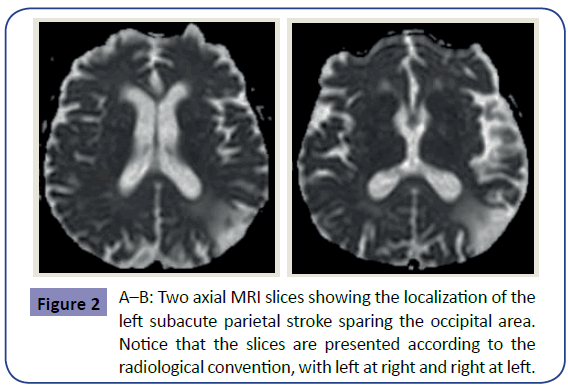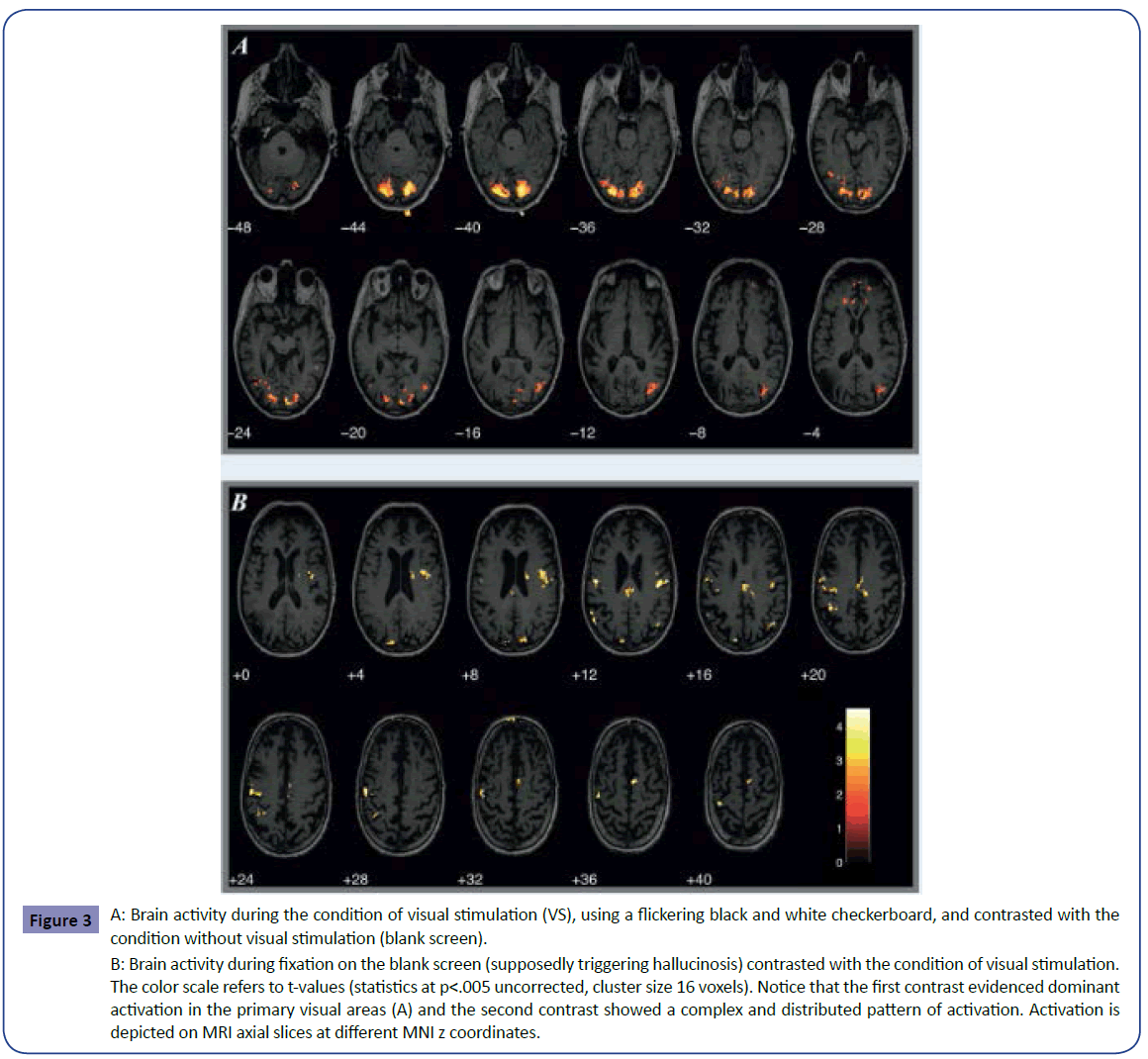Commentary - (2016) Volume 2, Issue 1
André Zacharia1*, Asaid Khateb2 andJean-Marie Annoni1,3
1Clinic of Neurology, Department of Clinical Neuroscience, Geneva University Hospitals and Faculty of Medicine, Geneva, Switzerland
2The Edmond J Safra Brain Research Center for the Study of Learning Disabilities and Department of Learning Disabilities, Faculty of Education, University of Haifa, Israel
3Neurology Unit, LCNS, Department of Medecine, University and Hospital of Fribourg, Switzerland
Corresponding Author:
Asaid Khateb
The Edmond J Safra Brain Research Center for the Study of Learning Disabilities and Department of Learning Disabilities Faculty of Education
University of Haifa, Mount Carmel, Haifa 31905, Israel
Tel: 0097248288600
Fax: +97248288435
E-mail: akhateb@edu.haifa.ac.il
Received Date: January 29, 2016; Accepted Date: March 01, 2016; Published Date: March 07, 2016
Citation: Zacharia A, Khateb A, Annoni JM. Peduncular-like Hallucinosis in the Absence of Midbrain or Thalamic Damage. Clin Psychiatry. 2016, 2:1. doi: 10.21767/2471-9854.100018
Copyright: © 2016 Zacharia A. This is an open-access article distributed under the terms of the Creative Commons Attribution License, which permits unrestricted use, distribution, and reproduction in any medium, provided the original author and source are credited.
An 87 year-old man was admitted for Peduncular hallucinosis (PH) characterized by acute vivid, continuous, complex visual and auditory hallucinations, which were triggered by fixation on a blank wall. The MRI revealed a subacute left parietal stroke. The symptoms disappeared after six weeks. An fMRI experiment, using periods of visual stimulation (checkerboard, VS) alternating with a hallucinosis-inducing condition (blank screen, PH) revealed that PH relative to VS elicited a complex pattern of activation involving the posterior cingulate cortex, the SMA, the left superior temporal gyrus and inferior parietal lobule. This is, to our knowledge, the first observation which indicated that PH-like could occur following cortical lesions. Moreover, fMRI results suggested that the internally-generated vivid and complex scenes in the patient’s brain were subtended by large associative neural networks that did not necessarily implicate the midbrain.
Introduction
Peduncular hallucinosis (PH) is vivid complex, permanent, scenic visual hallucinations experienced by patients normally awake. PH may be accompanied by auditory or tactile hallucinations such as liturgical sounds [1,2]. Patients find often the hallucinosis amazing but remain skeptical. Classically, PH occur after a midbrain lesion, generally with awareness at least partially preserved [2]. PH were mainly described following pontine, cerebellar and thalamic strokes [3,4], but not after cortical lesions. Functional investigations showed that hallucination-associated activation might involve specialized cortical regions, depending on the visual hallucination’s content [5,6].
One suggested mechanism for explaining PH is the loss of cortical control by the brainstem, either through modification of the thalamic gating mechanisms to visual/auditory cortices or through abnormal amplification of the thalamic input to sensory cortices. Another, hypothetical, mechanism points to the deregulation of information processing between the basal ganglia and visual temporal structures [7,8].
In this study, we report an unusual case of a man admitted for vivid and continuous hallucinosis, suggestive of PH, with an absence of brainstem damage but having a subacute left parietal lesion. A functional magnetic resonance imaging (fMRI) study was conducted to verify if the visual symptoms were associated with cortical activation. This is, to our knowledge, the first functional imaging study in PH [9-11].
Case Report
PG, an 87 year-old patient, was admitted to the Neurology clinic (five days after an operation on his knee) because of persistent hallucinosis, characterized by panoramic scenes of helicopters and a large river with a crowd of bathers. The images were reported to be seen on the wall of the room, reaching >150 degrees of visual angle. They were colorful, changing according to the vision line, and accompanied by liturgical songs. Initially, the hallucinosis was mixed with positive after images. The patient stated that the images he had seen on television persisted on the wall, as described in other cases of PH [4]. Sometimes, the patient reported the impression of being in one of the helicopters, and observed the scene below from 100-200 meters height. He could see the different branches of the river (“like the Ganges river delta”) (Figure 1).

Figure 1: The patient’s drawings of the visual scene he described at two different occasions. Notice the reproducibility of some specific details such as the location of the sea (indicated in both images by the word “MER” in French). The patient also gave indication in the two drawings to the directions (S for south, N for north and ES for east).
The hallucinosis appeared when the patient looked at the blank wall, and disappeared when closing eyes. During two weeks, the patient, who nevertheless remained skeptical, experienced these hallucinoses continuously. He showed a relative interest in his hallucinosis and found it amusing. Otherwise, the emotional reaction was minor, with no behavioral abnormalities. The neurological examination was normal, except a slightly decreased visual acuity of 60% in the left eye and 40% in the right eye and a left Babinsky sign (Table 1). The Mini Mental State Examination (MMSE) on admission showed a score of 24/30 (two points lost in orientation, one point in calculation and three points in recall). Subsequent formal neuropsychological evaluation during the PH phase showed an improvement in orientation and cognitive functions (Table 2).
| Tests | Observations |
|---|---|
| Visual acuity | Right eye : 0.6, left eye : 0.4 |
| Visual field, digital confrontation | Unremarkable deficit |
| Fundus | Suspicion of ARMD |
| Oculo-motricity | Unremarkable, no skew deviation |
| Rapid pursuit | Saccadic |
| Fixation saccade | Hypometric |
Table 1: Summary of the ophthalmological examination.
| Cognitive domain | Observations and sub-tests |
|---|---|
| Behavior | Presence of the hallucinosis, but no other trouble concerning his behavior |
| Orientation | Oriented in space and time. Able to state his birthday and his identity |
| Oral language | Spontaneous speech: fluent and informative Denomination (DO 80): 78/80 normal Verbal fluency: semantic condition: normal (22 animals in two minutes) Comprehension : normal in testing situation |
| Written language | Automatic production: first name and last name are normal Writing to dictation: Difficulty in producing the shape of letters, but a short sentence is in general correctly performed (one missing letter). Oral spelling is correct Reading aloud is normal and the patient can return to the main theme of the text |
| Oral calculation | Arithmetic facts and procedures are normal |
| Praxis | Limb and oro-facial praxis are good |
| Visual gnosia | Identification of drawings and colour recognition: normal |
| Executive functions | Phonological fluency: lower in standard impaired literal condition: (7 words by M in one minute) Figural fluency (five points): very impaired Conflicting instructions: well performed |
| Memory | Learning a list of 10 words shows a deficit (total of 10 words, 3 evocations). Delayed recall is 0 Recognition is good (8/10 words) |
Table 2: Summary of the formal neuropsychological testing performed three days before the fMRI experiment.
There was neither fluctuation of alertness nor of attention. The patient scored one out of four in the Confusion Assessment Method which excluded delirium. The cerebral MRI revealed no brainstem lesions, but a small chronic cortical frontal premotor stroke and a subacute left parietal stroke (Figure 2). This latter lesion predominated in the superior parietal lobule, behind the central sulcus. Lesion analysis using the MNI coordinates (x,y,z = 48,-69,15) suggested an extension towards the temporal lobe/ Brodmann area 39.

Figure 2: A–B: Two axial MRI slices showing the localization of the left subacute parietal stroke sparing the occipital area. Notice that the slices are presented according to the radiological convention, with left at right and right at left.
EEG recordings during hallucinosis showed normal reactive patterns. The follow-up assessment conducted by telephone one year later indicated that the patient was living alone in his house but with some help from family. He was orientated in space and time, could recognize the neurologist in charge (AZ) and showed no clinically significant cognitive impairment. Also, the follow-up at one year carried out by his general practitioner confirmed that he was independent and could perform daily activities and showed neither substantial cognitive impairment nor hallucinations.
fMRI Experiment
We first asked the patient to give his formal consent to participate in an fMRI acquisition session. This aimed at comparing brain activation between periods where hallucinosis was present versus periods where hallucinosis was absent. Two experimental conditions were alternated five times (in periods of 24s) during the functional acquisitions: 1) a condition without hallucinosis (ie., visual stimulation = VS), where a black and white flickering checkerboard was presented on a grey isoluminant screen, a condition hypothesized to suppress the hallucinosis and evoke responses in the visual cortex; and 2) a condition with hallucinosis (PH condition), where the patient had to fixate on a blank screen, which mimicked his room's wall, to trigger the hallucinosis. The patient’s verbal report after this session confirmed that VS stopped hallucinosis while the blank screen allowed its appearance. Data preprocessing and statistical analyses were conducted using SPM5 standard procedures.
Figure 3 , the comparison of functional responses between VS and PH conditions showed, as expected, a dominant activation in bilateral visual areas (Figure 3A). Contrasting PH against VS showed a complex pattern of activation involving the: posterior cingulate cortex, supplementary motor area (SMA), left superior temporal gyrus and inferior parietal lobule (Figure 3B). No activation was observed in the brainstem.

Figure 3: A: Brain activity during the condition of visual stimulation (VS), using a flickering black and white checkerboard, and contrasted with the condition without visual stimulation (blank screen).
B: Brain activity during fixation on the blank screen (supposedly triggering hallucinosis) contrasted with the condition of visual stimulation. The color scale refers to t-values (statistics at p<.005 uncorrected, cluster size 16 voxels). Notice that the first contrast evidenced dominant activation in the primary visual areas (A) and the second contrast showed a complex and distributed pattern of activation. Activation is depicted on MRI axial slices at different MNI z coordinates.
Discussion
This case highlights firstly that PH-like symptoms could occur in the absence of brainstem or thalamic lesions but after a cortical parietal one. Secondly, fMRI experiment indicated the activation of multisensory associative structures rather than visual associative ones.
The patient PG presented clinical features which pointed to PH. Charles Bonnet Syndrome (CBS) appeared unlikely since PG's symptoms occurred mainly with minimally impaired visual acuity, were multimodal and occurred throughout the whole day rather than in the evening or the morning. Release hallucinations were discarded despite the subacute left posterior stroke, since hallucinations were present in the whole visual field instead of only one affected visual field as in posterior cerebral artery infarction. Moreover, no visual field defect was present. One could speculate that the hallucinosis in this case might have resulted from the release of contralateral inhibition from the parietal cortex of the left language dominant hemisphere onto the right. Indeed the right hemisphere is known for being more specialized in processing spatial information. As spatial features are prominent in this case a disturbed interaction between both parietal hemispheres could possibly lead to PH.
A post-surgical delirium in the context of neurodegenerative process has not been retained given his awareness of the unreality of his hallucination, absence of confusion, and MMSE on admission being in the normal range. The neuropsychological examination was nearly normal, except for decreased learning abilities. It did not point to amnesic syndrome or any other form of confabulations. The follow-up contact at one year argued against a progressive dementia. Finally, a possible missed brainstem or thalamic lesion seemed unlikely.
The fMRI analysis should be interpreted cautiously due to the lack of any normative data, and to the fact that we relied entirely on the patient’s report. Nevertheless, the comparison of PH to VS showed a complex pattern of activation that did not involve the brainstem or the thalamus. The absence of activation in the brainstem was in accordance with the expected physiopathology of PH, which seems to be due to damage to the ascending reticular system and thalamocortical circuits [4,7]. Our fMRI tends to show a complex and widelydistributed set of brain regions that might be part of the “brain’s default network” which activates during resting states and includes the posterior cingulate cortex and the inferior parietal lobule [10] . However, since it is known that the same brain areas are also engaged during moments of conscious and spontaneous mental activity, such as in autobiographical memory tasks [10], it could not be excluded that part of these areas participates in hallucinosis generation as a specialized form of mental activity.
Our fMRI study did not demonstrate any activation of neither the anterior cingulate nor the orbitofrontal cortex, which are often activated in reality-monitoring tasks [11]. These areas seem however to be part of brain regions hypothesized to participate in CBS [5,6]. Our observations suggest that PH might represent a clinically and physiologically different phenomenon from the release hallucinations. Further research on PH and other types of hallucinations using fMRI is necessary to disentangle the neurophysiological bases of such complex phenomena.
The treatment given to the patient was Pregabalin which presumably had a good effect as the symptoms settled two weeks later without recurrence, In case of bothersome PH this option might be worth to try. No clinical trial to our knowledge is available for this condition but cases reported in the literature mention also neuroleptics.
Conclusion
This case report indicated that PH can occur without clinical or radiological involvement of the brainstem or the thalamus as initially described. Moreover the fMRI findings suggest that the internally generated vivid and complex scenes in the patient’s brain were subtended by a large neural network that did not imply necessarily the midbrain, the brainstem or the thalamus, confirming the possibility of PH arising also outside of the brainstem.
Acknowledgment
This work was supported by the Swiss National Science Foundation grant no 325100-118362.